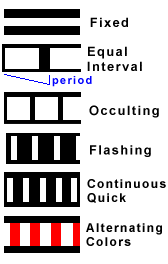

Early lamps used in lighthouses were sooty, hard to keep burning in cold and drafty conditions, not very effective as beacons, and often had toxic fumes. The most widely used lamp until 1812 was the spider lamp, which had a shallow brass pan as a reservoir and four to eight adjustable solid round wicks (without chimneys) that surrounded the pan.
In 1781 a Swiss chemist named Amee Argand invented a lamp that was as bright as seven candles. It had two cylinders of brass: one inside to feed oil to the lamp's wick, and one outside to bring oxygen around the wick. This lamp used half the oil of the spider lamp. A parabolic reflector helped to magnify the light. By 1800 the lamp was in wide-spread use in europe, and it is believed that the first Argands lamp was used in an American lighthouse in 1809.
In 1812 the U.S. Government purchased a patented "reflecting and magnifying lantern" from a former ship captain - Winslow Lewis. His catoptric (reflective) optic was made of ten whale oil-burning lamps, each of which had its own parabolic reflector. Later, Lewis used round green glass or plano-convex lenses in front of the lamps. In reality, his "invention" was a modified version of the Argand lamp. It was, also, flawed: the reflectors were more spherical than parabolic, the silver backing was easily rubbed off, parts were not securely fastened, poorly-made brass gears wore out, and they were easily fouled by dust and grit. Despite these problems, Lewis' lamps were placed in all 49 of America's lighthouses, in a large part due to Lewis' friendship with Stephen Pleasonton. Pleasonton worked in the Department of State and Patent Office, later became head of the Lighthouse Service. Years later, a nephew of Lewis would help bring charges against Pleasonton for mis-managing the Service.
In 1822 Augustin Jean Fresnel (pronounced fra nell) introduced the lens that would change the world of lighthouses. The French physicist had made a lens shaped like a bullet. Directly over and under the central glass drum are curved dioptic prisms and then above those are curved catadioptic prisms. Around the fixed lens' waist is a central drum of convex glass; the revolving optic employs a series of convex bullseye lenses. The lens has a delicate balence, is easily rotated and was extremely well-made.
The principles of physics applied here are of refraction (bending) and reflection. The two types of prisms bend and reflect light rays: by positioning the prisms around the outside of the lens so that all emerging light rays are parallel to each other, the lens is capable of collecting up to 90% of the lamp's light and focusing it into an intense horizontal beam.
 Any altering of a beam produces each light station's light characteristic, by which they are classified. Moving screens (also called eclipsers) could be placed in front of the optic. Rotating the Fresnel's vertical segments of prisms resulted
in funneling the light into vertical or pencil beams. Sometimes a colored light sector is used. It is an arc of light seen as a ship approaches the lighthouse.
Any altering of a beam produces each light station's light characteristic, by which they are classified. Moving screens (also called eclipsers) could be placed in front of the optic. Rotating the Fresnel's vertical segments of prisms resulted
in funneling the light into vertical or pencil beams. Sometimes a colored light sector is used. It is an arc of light seen as a ship approaches the lighthouse.
